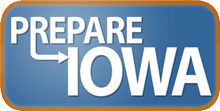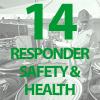


Capability 14: Responder Safety and Health
Definition: The responder safety and health capability describes the ability to protect public health agency staff responding to an incident and the ability to support the health and safety needs of hospital and medical facility personnel, if requested.
Functions and Associated Performance Measures: This capability consists of the ability to perform the functions listed below. At present there are no CDC-defined performance measures for these functions.
Function 1: Identify responder safety and health risks
Function 2: Identify safety and personal protective needs
Function 3: Coordinate with partners to facilitate risk-specific safety and health training
Function 4: Monitor responder safety and health actions
 Personal Protective Equipment (PPE) [1]
Personal Protective Equipment (PPE) [1]
This course is designed for local public health agencies and professionals who may be involved in public health disasters. The goals of the course are to: Increase awareness of the importance of using PPE in public health emergencies and crises; Reinforce appropriate PPE in different crisis situations and biohazards. The intended audience for this course is local public health employees/ agencies and “on site” professionals who may be involved in public health emergencies such as flooding, disease outbreak, hurricanes and floods, debris cleanup, mass fatalities, or any other related public health emergencies.
 Ready or Not? A Family Preparedness Scenario [2]
Ready or Not? A Family Preparedness Scenario [2]
This interactive, scenario-based course, developed by the Upper Midwest Preparedness and Emergence Response Learning Center, provides training in emergency preparedness for the families of those involved in disaster response, focusing on actions familes can take prior to a disaster. The course takes about 50 minutes or less to complete.
 HAZMAT for Healthcare Providers — Awareness Level [3]
HAZMAT for Healthcare Providers — Awareness Level [3]
This course is intended for health care workers in a hospital environment who may potentially have contact with a contaminated patient. The presence of hazardous materials in an Emergency Department is a risk to everyone - hospital personnel, patients and other people within the hospital. During HAZMAT incidents, hospital personnel should have two main goals: - To protect both themselves and others from exposure to the hazardous material - To provide the same level of care for the contaminated patient as any other patient This course is intended to help you respond to incidents involving hazardous materials in a way that meets these two goals.
 HAZMAT for Healthcare Providers — Operations Level [3]
HAZMAT for Healthcare Providers — Operations Level [3]
This course is intended for health care workers in a hospital environment who may need to respond to an incident involving a contaminated patient on the operations level. Prerequisite: HAZMAT Awareness for Healthcare Providers is a prerequisite for this course.
 HAZMAT for First Responders [3]
HAZMAT for First Responders [3]
The presence of hazardous materials in an Emergency Department is a risk to everyone - hospital personnel, patients and other people within the hospital. During HAZMAT incidents, hospital personnel should have two main goals: 1. to protect both themselves and others from exposure to the hazardous material 2. to provide the same level of care for the contaminated patient as any other patient This course, designed for health care workers in a hospital environment who may potentially have contact with a contaminated patient, is intended to help you respond to incidents involving hazardous materials in a way that meets these two goals.
Protective Action Guides (PAGs) [4]
The Environmental Protection Agency (EPA) developed the PAG Manual to provide guidance on protective actions and when to take them. The manual contains radiation dose guidelines that would trigger protective actions like evacuation or staying indoors. The PAG Manual is a planning guide for emergency responders, and applies to any radiation incident.
Emergency Response Guidebook (ERG) [5]
From U.S. Department of Transportation, the Pipeline and Hazardous Materials Safety Administration (PHMSA) provides first responders with the Emergency Response Guidebook, a go-to manual to help deal with hazmat accidents during the critical first 30 minutes. PHMSA's goal is to place an ERG in every emergency service vehicle nationwide. To date, nearly 11 million free copies have been distributed to the emergency response community through state emergency management coordinators.
CDC Radiological Terrorism: Just in Time Training for Hospital Clinicians [6]
This brief (17-min) video from the CDC covers key radiation principles and radiological procedures. Includes demonstrations on applying these principles and procedures in several patient care scenarios in an emergency services setting.
CDC Radiological Terrorism: Tool Kit for Public Health Officials [7]
To bridge gaps in knowledge and skills regarding terrorism response and planning efforts for radiological or nuclear events, the CDC has assembled this toolkit. It includes education on planning for radiological and nuclear terrorism, monitoring in radiation emergencies, guidelines for handling contaminated decedents, and how to use hand-held radiation survey equipment to screen people for contamination.
The National Clearinghouse for Worker Safety and Health Training [8]
The National Clearinghouse for Worker Safety and Health Training from National Institute of Environmental Health Sciences is the national resource for hazardous waste worker curricula, technical reports, and weekly news on hazardous materials, waste operations and emergency response.
Pocket Guide to Chemical Hazards [9]
The NIOSH Pocket Guide to Chemical Hazards is intended as a source of general industrial hygiene information for workers, employers, and occupational health professionals. The industrial hygiene information found in the Pocket Guide should help users recognize and control occupational chemical hazards.
National Planning Scenarios [10]
The Federal interagency community has developed 15 all-hazards planning scenarios (the National Planning Scenarios or Scenarios) for use in national, Federal, State, and local homeland security preparedness activities. The Scenarios are planning tools and are representative of the range of potential terrorist attacks and natural disasters and the related impacts that face our nation. The objective was to develop a minimum number of credible scenarios in order to establish the range of response requirements to facilitate preparedness planning.
Links
[1] http://go.prepareiowa.com/url/la
[2] http://go.prepareiowa.com/url/kj
[3] http://go.prepareiowa.com/url/k4
[4] http://www.epa.gov/radiation/rert/pags.html
[5] http://www.tc.gc.ca/media/documents/canutec-eng/erg2008eng.pdf
[6] http://emergency.cdc.gov/radiation/justintime.asp
[7] http://emergency.cdc.gov/radiation/publichealthtoolkit.asp
[8] http://tools.niehs.nih.gov/wetp/
[9] http://www.cdc.gov/niosh/npg/npgsyn-c.html
[10] https://secure.nccrimecontrol.org/hsb/planning/Planning%20Documents/National%20Planning%20Scenarios%202006.pdf